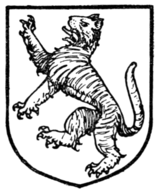CHAPTER XII
BEASTS
NEXT after the lion should be considered the tiger, but it must be distinctly borne in mind that heraldry knows two kinds of tigers—the heraldic tiger (Figs. 322 and 323) and the Bengal tiger (Figs. 324 and 325). Doubtless the heraldic tiger, which was the only one found in British armory until a comparatively recent date, is the attempt of artists to depict their idea of a tiger. The animal was unknown to them, except by repute, and consequently the creature they depicted bears little relation to the animal of real life; but there can be no doubt that their intention was to depict an animal which they knew to exist. The heraldic tiger had a body much like the natural tiger, it had a lion's tufted tail and mane, and the curious head which it is so difficult to describe, but which appears to be more like the wolf than any other animal we know. This, however, will be again dealt with in the chapter on fictitious animals, and is here only introduced to demonstrate the difference which heraldry makes between the heraldic tiger and the real animal. A curious conceit is that the heraldic tiger will anciently be often found spelt "tyger," but this peculiar spelling does not seem ever to have been applied to the tiger of nature.
{{nop]]




